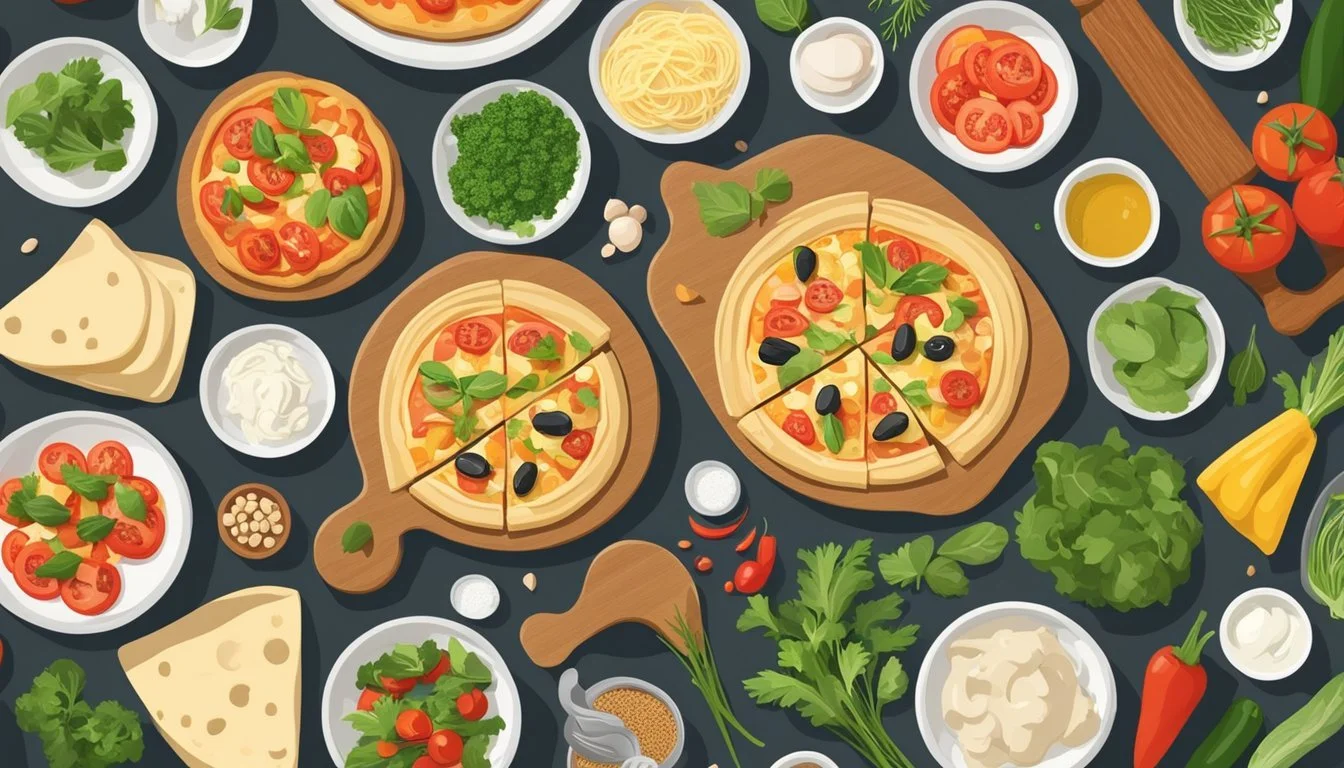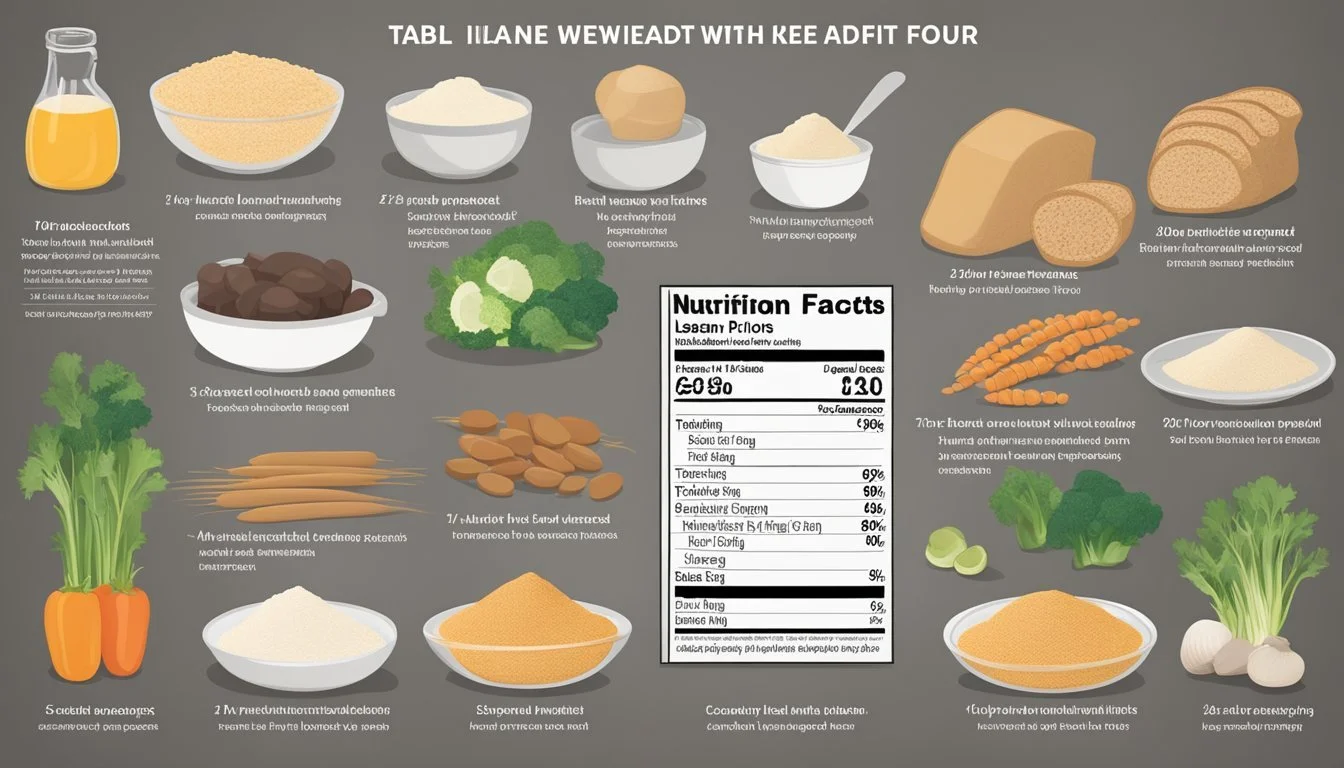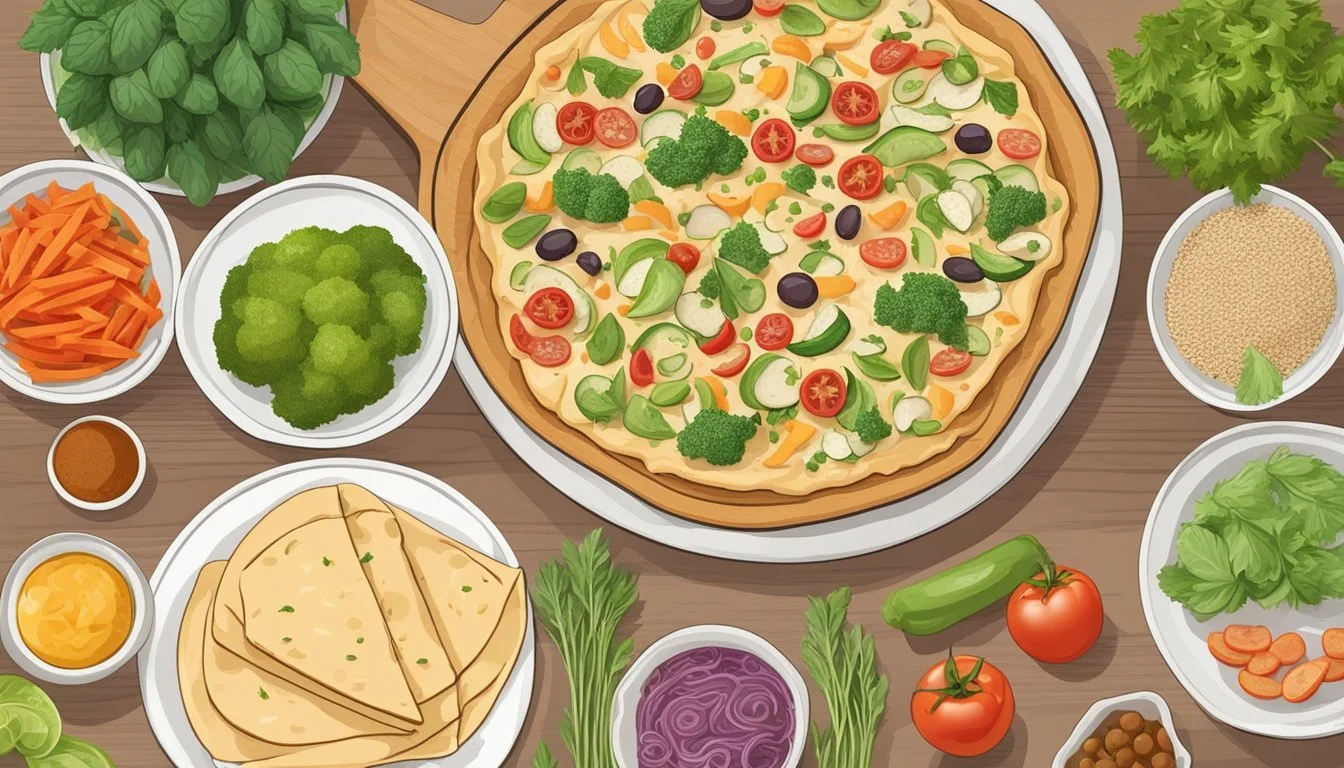6 Meal Prep Recipes for Healthy Pizza and Flatbreads
Quick and Nutritious Options
Pizza (What wine goes well with pizza?) and flatbreads have become staples in the modern diet, offering a versatile canvas for a myriad of delicious toppings. However, with busy schedules and health-conscious eating habits on the rise, individuals are turning towards meal prep as a solution to maintain a balanced diet without sacrificing the joys of indulging in these beloved dishes. Recognizing this shift, the culinary world has adapted, creating an array of meal prep recipes that cater to the need for convenience while keeping health at the forefront.
These recipes are crafted to offer the taste and satisfaction of classic pizzas and flatbreads, while incorporating nutritional elements such as whole grains, fresh vegetables, and lean proteins. The emphasis is on techniques such as par-baking dough for an optimal crust, using cooking sprays instead of excessive oils, and adding flavors through herbs and spices rather than heavy sauces. They are designed not only to nourish but also to save time, allowing for a quick assembly and efficient cooking processes that fit seamlessly into a hectic week.
The result is a collection that promises a guilt-free experience without compromising on flavor or texture. From flatbreads garnished with greens and grilled chicken to pizzas layered with beans, corn, and carefully selected cheeses, each recipe is a testament to the equation where convenience meets health. These meal prep ideas seek to redefine fast food as something that can be both wholesome and homemade, sticking to the ethos of eating well in a fast-paced world.
Selecting the Right Ingredients
In crafting healthy pizza and flatbreads, selecting high-quality, nutritious ingredients is crucial. The right blend of crust, toppings, and cheeses enhances both the taste and nutritional profile.
Choosing a Healthy Crust
The foundation of any pizza or flatbread is the crust. Options for a healthy crust include whole-wheat dough for added fiber, or cauliflower crusts for a lower-carb alternative that provides additional nutrients. Selecting a base high in fiber is beneficial for a balanced diet.
Types of Healthy Crusts:
Whole-wheat dough
Cauliflower crust
Sweet potato base
Flatbread made with gluten-free flour
Opting for Nutrient-Dense Toppings
Toppings are where one can get creative and nourish the body with vitamins and minerals. Layering vegetables such as spinach (What wine goes well with spinach?), bell peppers (What wine goes well with bell peppers?), and mushrooms adds flavor and fiber, while opting for tomato-based sauces can provide lycopene, an antioxidant with numerous health benefits.
Examples of Nutrient-Dense Toppings:
Spinach: for iron and calcium
Bell peppers: for vitamin C and A
Mushrooms: for vitamin D
Cherry tomatoes: for lycopene
Incorporating a variety of veggies not only improves nutrition but also enhances the pizza's visual appeal and taste. Using olive oil as a base or drizzle can add monounsaturated fats, which are beneficial for heart health.
Sourcing Quality Cheeses and Meats
Choosing the right cheese can make a significant difference in limiting saturated fat intake. Low-fat mozzarella is a good option as it provides protein and calcium with a reduced amount of saturated fat. For meats, selecting lean proteins such as grilled chicken or turkey can further reduce fat content while maintaining flavor.
Cheese and Meat Selections:
Low-fat mozzarella: reduced saturated fat
Feta or goat cheese: adds flavor with less fat
Grilled chicken: for a lean protein option
Turkey pepperoni: for a lower fat meat choice
The right selection of ingredients not only boosts the taste but also the overall nutritional value of pizzas and flatbreads. By focusing on these components, one can enjoy a healthier version of their favorite meals.
Step-by-Step Cooking Instructions
The key to successful meal prep for healthy pizza and flatbreads is a well-executed cooking process. Follow these precise steps to ensure delicious outcomes that can be enjoyed immediately or reheated with ease later on.
Preparing the Dough
For pizza and flatbread dough, one can start with store-bought pizza dough, pita, naan, or create the dough from scratch. The prep time for homemade dough typically takes around 15 minutes, followed by a rising time which can vary depending on the recipe. If the preference leans towards traditional pizza dough, combine yeast, warm water, flour, olive oil, and salt, kneading until smooth before allowing it to rise. For flatbreads like pita or naan, the total time may differ due to variations in dough thickness and ingredients.
Assembling the Pizza and Flatbreads
To assemble the pizza and flatbreads:
Preheat the oven to the baking temperature outlined in the specific recipe, usually around 475°F (245°C) for pizza.
Roll out the dough onto a floured surface to prevent sticking. For individual portions, divide the dough accordingly.
Transfer the dough onto a baking sheet lined with parchment paper.
Spread a layer of pizza sauce onto the dough, leaving space at the edges for the crust.
Add toppings of choice while being careful not to over-top, as this might lead to a soggy crust.
For flatbreads that require less or no sauce, arrange the toppings to cover most of the surface for a balance in every bite.
Baking to Perfection
Baking involves careful monitoring to achieve a crispy crust and well-cooked toppings:
Place the pizza or flatbreads in the preheated oven on the middle rack to ensure even cooking.
The baking time will typically range from 10 to 15 minutes for pizza and possibly less for thinner flatbreads.
The pizza or flatbread is done when the crust is golden and crisp, and the cheese (if used) is bubbling.
Once baked, let it cool for a few minutes before slicing. This allows the cheese and toppings to set, preventing them from sliding off when cutting.
When meal prepping, allow pizzas and flatbreads to cool completely before storing to maintain texture when reheating.
Healthy Pizza and Flatbread Recipes
These recipes offer a delightful spin on traditional favorites, incorporating a range of fresh, nutritious ingredients without sacrificing flavor. Tailored for health-conscious food lovers, each dish balances taste with wholesome benefits.
Classic Margherita Flatbread
A light and crispy base spread with a simple tomato sauce is topped with slices of mozzarella cheese and fresh basil leaves. After a brief stint in the oven, this easy-to-prepare flatbread emerges with a tantalizing aroma and classic flavors.
Ingredients:
Pre-made flatbread
Tomato sauce
Fresh mozzarella slices
Basil leaves
Oven Temperature: 425°F
Cook Time: 8-10 minutes
Grilled Chicken and Spinach Pizza
Layer grilled chicken breast and spinach over a whole-wheat pizza crust for a nutritious twist. Finish it with mozzarella and parmesan cheese for a melt-in-your-mouth experience that pairs protein with greens.
Ingredients:
Whole-wheat pizza dough
Cooked chicken breast
Baby spinach
Mozzarella and parmesan cheese
Oven Temperature: 475°F
Cook Time: 10-12 minutes
Veggie Delight with Homemade Sauce
Spread homemade tomato sauce on a crust, heap it with colorful bell peppers, onions, mushrooms, zucchini, and black olives. Sprinkle with a mix of mozzarella and cheddar for a vibrant, veggie-packed pizza.
Ingredients:
Pizza dough of choice
Homemade tomato sauce
Assorted vegetables (bell peppers, onions, mushrooms, zucchini, olives)
Mozzarella and cheddar cheese
Oven Temperature: 450°F
Cook Time: 12-15 minutes
Meaty Feast with Low-Calorie Options
Make a protein-rich pizza using lean ground sausage, bacon bits, and turkey pepperoni. Opt for a thin crust and part-skim mozzarella to keep calories in check without compromising the hearty flavors.
Ingredients:
Thin pizza crust
Lean sausage, bacon, turkey pepperoni
Part-skim mozzarella
Oven Temperature: 425°F
Cook Time: 8-10 minutes
Sweet and Savory Apple & Red Onion Flatbread
A unique combination of thinly sliced apples and red onions atop a flatbread, complemented by a sprinkle of goat cheese or gorgonzola. The sweetness of the apples pairs perfectly with the sharpness of the onions and cheese.
Ingredients:
Flatbread
Apple slices
Red onion slices
Goat cheese or gorgonzola
Oven Temperature: 400°F
Cook Time: 10-12 minutes
Gluten-Free Pita Pizzas
For those avoiding gluten, pita bread can serve as a great base for custom pizzas. Top with tomato or alfredo sauce, any desired veggies, and protein like shredded chicken or sausage. Use gluten-free pita and sprinkle with your cheese of choice.
Ingredients:
Gluten-free pita bread
Sauce (tomato or alfredo)
Desired toppings (chicken, sausage, veggies)
Cheese (mozzarella, cheddar, etc.)
Oven Temperature: 425°F
Cook Time: 6-8 minutes
Nutritional Information and Health Benefits
When crafting meal prep recipes for healthy pizza and flatbreads, understanding the nutritional breakdown is essential. It helps one ensure that their meals are balanced in terms of macronutrients and provide an array of vitamins and minerals essential for overall health.
Understanding Macronutrients in Recipes
Calories in meal prep recipes for pizza and flatbreads vary. Whole-grain crusts, which are a healthier alternative to white flour crusts, contain complex carbohydrates that offer sustained energy and fiber for digestive health. The protein content can be adjusted with the choice of toppings like chicken or a variety of plant-based options. Fat should primarily come from healthy sources; for instance, monounsaturated and polyunsaturated fats are preferable. These can be found in toppings like avocado slices, or when using oils, one should opt for olive oil.
Carbohydrates: Aim for whole-grain crusts.
Fat: Prefer sources like olive oil for heart health.
Protein: Include lean meats or plant-based proteins.
Fiber: Whole grains and vegetables can boost fiber content.
By carefully selecting ingredients, one can manage saturated fat, cholesterol, and sodium levels, all of which should be kept to a minimum to maintain heart health. For instance, reduced-fat or plant-based cheese can be used to lower saturated fat and cholesterol.
Assessing Vitamins and Mineral Content
Vitamins like vitamin A and vitamin C are abundant in vegetable toppings, like bell peppers and tomatoes, which are also low in calories and sugar. These micronutrients support immune function and skin health. Incorporating a variety of vegetables can also ensure an intake of potassium and iron.
Vitamin A: Found in toppings like spinach and carrots.
Vitamin C: Abundant in bell peppers and tomatoes.
Calcium: Can be provided by cheese; using a reduced-fat variety can reduce calorie intake.
Iron: Often available in green leafy toppings.
When constructing your pizza or flatbread, one should strive for a balance, ensuring that each serving provides nutritional benefit without excess calories or unhealthy fats. Opting for toppings rich in monounsaturated and polyunsaturated fat can contribute positively to heart health, while fiber from whole grains and vegetables enhances satiety and supports a healthy digestive system.
Meal Prep and Storage Tips
Preparing pizza and flatbread in advance saves time and ensures a healthy, quick meal option is always available. Effective storage techniques preserve freshness and flavor for when one is ready to enjoy their meal.
Making Pizza and Flatbread Ahead of Time
Dough Preparation: One can mix and knead their pizza or flatbread dough, divide it into individual portions, and freeze them in airtight bags. This approach can extend the dough's usability for up to three months, reducing prep time for future meal preparations.
Sauce Efficiency: Homemade pizza sauce, utilizing fresh or canned tomatoes, herbs, and seasonings, can be made in large batches. One should store it in meal-sized containers — either in the refrigerator for up to a week or in the freezer for three months.
Storing and Reheating for Best Quality
Freezing Method: After preparing pizza pockets or flatbreads, one should lay them on a baking sheet and freeze them individually. Once frozen solid, they can be transferred to freezer-safe containers or bags to prevent freezer burn and maintain quality.
Reheating Process: To reheat, one should place the frozen pizza or flatbread into a preheated oven at 350°F (175°C). The time will vary depending on the product's thickness, but typically it takes about 10-15 minutes for the meal to warm through and the crust to crisp up. It's crucial to avoid microwaving, as it can make the crust soggy.
Additional Tips and Variations
When crafting healthy pizzas and flatbreads, incorporating variety is key. Diversifying ingredients not only caters to different dietary needs but also keeps meals exciting and visually appealing, perfect for sharing on Instagram, Pinterest, or Facebook.
Creating Vegetarian and Vegan Options
One can easily adapt pizza and flatbread recipes to vegetarian and vegan diets by substituting meat toppings with a range of vegetables. For a veggie twist, try a combination of steamed broccoli, bell peppers, and black beans. For those following a vegan lifestyle, dairy cheese can be replaced with plant-based cheese alternatives. Utilizing nutritional yeast or a blend of mashed avocado and lemon juice can impart a cheesy flavor without animal products.
Vegetarian Variety:
Steamed broccoli
Bell peppers
Black beans
Plant-based cheese
Nutritional yeast
Avocado-lemon mixture
Exploring International Flavors
Exploring international flavors can transform an ordinary pizza into a culinary adventure. Seasonings play a crucial role in this, with spices such as cumin, coriander, or za'atar adding unique dimensions of taste. A Middle Eastern-inspired flatbread may feature a za'atar spread, while a Mexican variation could include enchilada sauce and queso fresco.
International Seasoning:
Cumin
Coriander
Za'atar
Recipe Ideas:
Middle Eastern Za'atar Flatbread
Mexican Enchilada Sauce Pizza
Tailoring Recipes to Dietary Restrictions
Tasty pizzas and flatbreads can be tailored to accommodate various dietary restrictions. Gluten-free crusts can be made using alternative flours such as almond or coconut flour. For those watching their calorie intake, using a thinner crust and a light sprinkle of cheese can help reduce the overall calorie content without compromising taste.
Coconut flour
Calorie-Conscious Tips:
Thinner crusts
Less cheese (light sprinkle)
Engagement and Sharing
Sharing healthy pizza and flatbread meal prep recipes can be engaging for both the creator and their audience. It's an excellent opportunity to showcase culinary skills, inspire others, and invite feedback to improve future recipes.
Showcasing Your Creations on Social Media
One can share their meal prep creations on Instagram to visually capture the appeal of the recipes. A well-composed image with vibrant toppings on a flatbread can attract likes and comments, while utilizing hashtags such as #MealPrepSunday or #HealthyPizza can help reach a broader audience. Pinterest is also ideal for sharing step-by-step photos or infographics of these recipes, optimized with descriptive, keyword-rich captions.
Gathering Community Feedback
After posting on platforms like Facebook food groups or Instagram, one should encourage their followers to try out the recipes and share their versions or suggestions. In the post description, questions like "What are your favorite flatbread toppings?" or "How do you make your pizza healthier?" can stimulate interaction. One can create a poll for feedback on recipe variations, or ask followers to comment their thoughts on new recipe ideas. Replies can provide constructive insights that not only improve recipe development but also cultivate a sense of community.
Conclusion
Incorporating meal prep strategies for healthy pizza and flatbread recipes can transform weeknight dinners into a stress-free delight. They offer versatility, time efficiency, and nourishment.
Encouraging Continuous Culinary Exploration
Exploring various healthy toppings, sauces, and crust options empowers home cooks to keep meals exciting and nutritious. It encourages a healthier approach to enjoying beloved dishes like pizza and flatbread, while also enticing palates with new flavor combinations.





